The Colosseum Underground, Arena Floor, and Ancient Rome, a captivating journey into the heart of history, beckons visitors to uncover the secrets of Rome’s grand past.
This article offers a unique perspective on the Colosseum, delving into its underground tunnels and arena floor, while exploring its connection to the ancient city. With an opportunity for special access, visitors can step back in time, standing where gladiators once battled for their lives and discovering the hidden chambers that held wild animals. Descending into the intricate network of underground tunnels, they can learn about the mechanisms used to release predators onto the arena floor.
Plus, this article will explore the Roman Forum and Palatine Hill, providing a self-guided tour through the remnants of emperors’ palaces and a chance to understand the historical significance of the Roman Forum.
Experience Rome’s rich history, learn about its ancient stories, and unlock the mysteries of the Colosseum Underground, Arena Floor, and Ancient Rome.
Good To Know
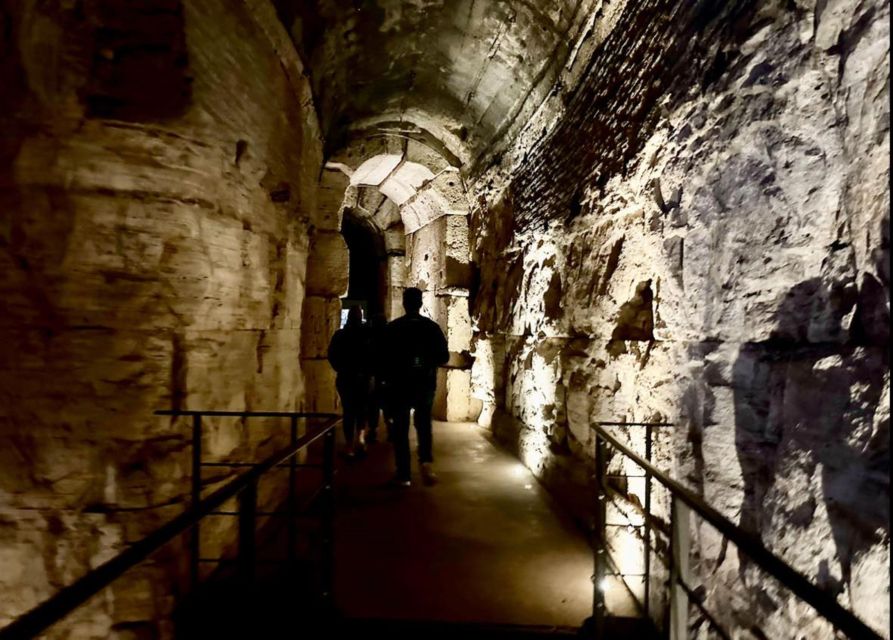
Image Credit: GetYourGuide.com
- The Colosseum is a monumental amphitheater in Rome, Italy, and is considered a masterpiece of Roman engineering.
- Special access and immersive experiences, such as fast-track entrance and exclusive access to the arena floor, provide a deeper understanding of Roman history and connect visitors with the past.
- Exploring the underground tunnels of the Colosseum uncovers hidden secrets and showcases the grandeur and ingenuity of ancient Roman entertainment.
- The Ludus Magnus, a gladiator training school located outside the walls of the Colosseum, played a crucial role in training gladiators and highlights the link between training and performances in the Colosseum.
It's also worth checking out some other tours and experiences nearby.
Fast-Track Entrance to the Colosseum
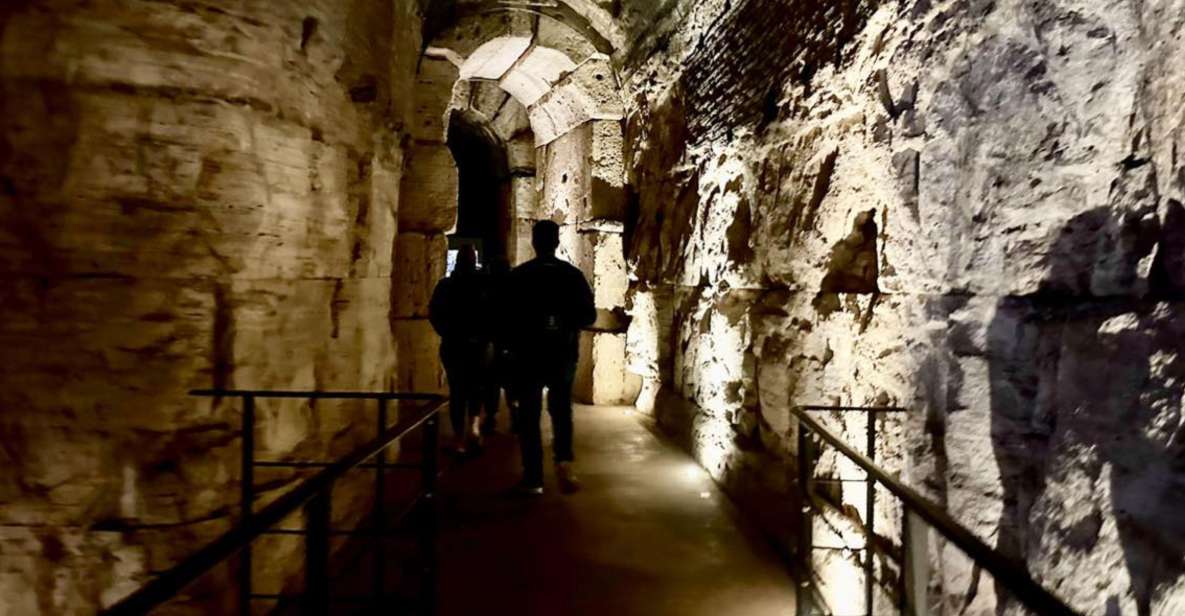
Image Credit: GetYourGuide.com
When entering the Colosseum, visitors can enjoy a fast-track entrance that allows them to bypass long lines and begin their exploration of this ancient wonder.
The Colosseum is a monumental amphitheater located in Rome, Italy. It was constructed during the Flavian dynasty in the first century AD and is considered a masterpiece of Roman engineering. With its elliptical shape and impressive size, the Colosseum could hold up to 50,000 spectators who gathered to witness gladiatorial contests, animal hunts, and other public spectacles.
The construction of the Colosseum took approximately eight years to complete, and it stands as a testament to the grandeur and architectural prowess of ancient Rome.
Exploring the Colosseum allows visitors to explore its rich history and imagine the vibrant events that once took place within its walls.
Special Access to the Arena Floor
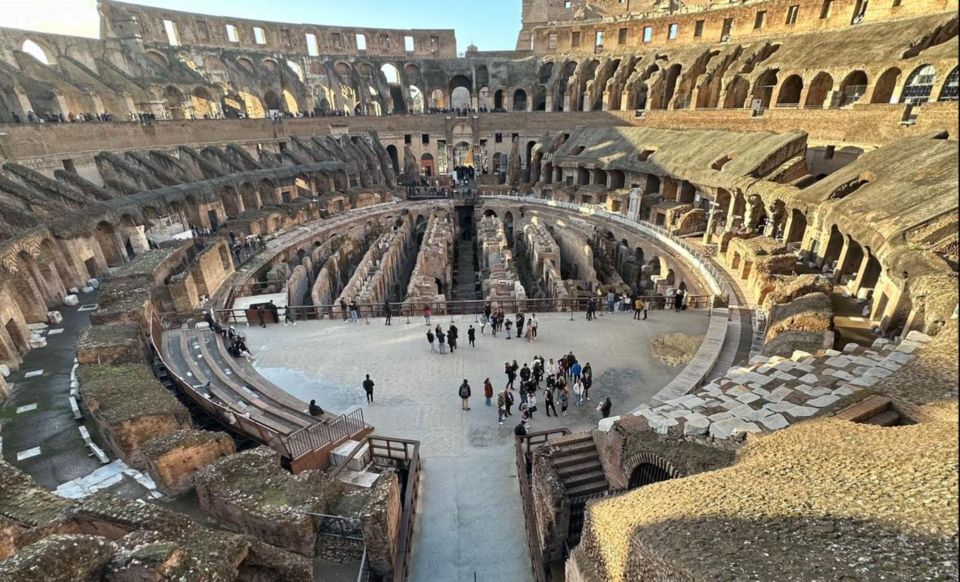
Image Credit: GetYourGuide.com
Visitors are granted exclusive access to the arena floor of the Colosseum, allowing them to step into the footsteps of gladiators and experience the vibrant history of ancient Rome. This special access benefits visitors by providing an immersive experience that brings them closer to the action that once took place in the grand amphitheater. Stepping onto the arena floor, visitors can imagine the roaring crowd and get a sense of what it was like to be a gladiator in the midst of battle. The historical significance of this access cannot be overstated, as it offers a unique opportunity to connect with the past and gain a deeper understanding of the Colosseum’s role in Roman society.
| Special Access Benefits | Historical Significance |
|---|---|
| Step into gladiators’ footsteps | Gain a deeper understanding of Roman history |
| Experience the grandeur of the Colosseum | Connect with the past |
| Imagine the roaring crowd | Appreciate the cultural significance |
Exploring the Colosseum’s Underground Tunnels
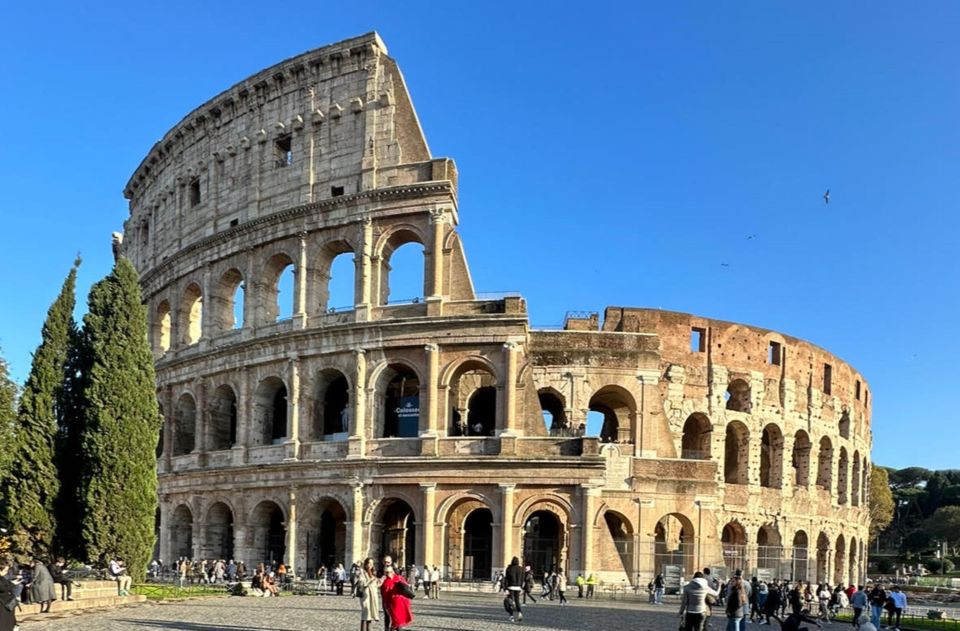
Image Credit: GetYourGuide.com
visitors can now explore the depths of the Colosseum’s underground tunnels to uncover its hidden secrets and enjoy the captivating history of ancient Rome. These hidden passageways offer a unique opportunity to unearths ancient secrets and gain a deeper understanding of the grandeur and brutality that once took place within these walls.
Here are three reasons why exploring the Colosseum’s underground tunnels is a must-do experience:
-
Discover the labyrinthine network of tunnels that connected the Colosseum to other parts of the city.
-
Witness the chambers that housed fierce and exotic animals, gaining insight into the spectacle of the gladiatorial games.
-
Stand where the gladiators once walked and imagine the roar of the crowd as you traverse the same paths they did thousands of years ago.
Embarking on this underground adventure allows visitors to truly enjoy the rich history of the Colosseum and experience the thrill of exploring hidden passageways firsthand.
Walking in the Footsteps of Gladiators
Tourists can now step into the shoes of gladiators and experience the adrenaline of walking in their footsteps at the Colosseum. The Colosseum offers a unique opportunity to explore the arena floor, where gladiators once fought for their lives. As visitors stand on the same ground where these epic battles took place, they can imagine the roaring crowd and the intensity of gladiatorial combat. To further enhance the experience, the Colosseum provides information on the training techniques employed by gladiators, giving visitors a glimpse into the rigorous preparation these warriors underwent. Through this immersive journey, travelers can gain a deeper understanding of the physical and mental challenges faced by gladiators, making for an unforgettable experience at one of Rome’s most iconic landmarks.
| Gladiatorial Combat | Training Techniques |
|---|---|
| Fierce Battles | Intensive Workouts |
| Roaring Crowd | Weapons Training |
| Life-or-Death | Endurance Exercises |
| Intense Competition | Combat Drills |
How To Reserve: This tour can be booked on GetYourGuide. They have a great cancellation policy which means you can save your spot now and can cancel for free right up to the day before.
Discovering the Chambers of Wild Animals
As you descend beneath the Colosseum, you’ll discover the chambers that once housed wild animals. These chambers were strategically designed to accommodate a variety of animal species, adding to the spectacle of the ancient Roman games.
Here are three fascinating features of the Colosseum’s animal chambers:
-
Chamber design: The chambers were ingeniously built underground, allowing for easy access to the arena floor. They were equipped with sturdy gates and barriers to ensure the safety of both the animals and the spectators.
-
Animal species: The chambers housed a diverse range of wild animals, including lions, tigers, elephants, and even exotic species brought from distant lands. These animals were carefully selected to provide thrilling and awe-inspiring entertainment for the crowds.
-
Preservation of nature: Despite the violent nature of the games, the Romans recognized the importance of preserving the animal species. The chambers were designed to provide a habitat that closely resembled the animals’ natural environment, ensuring their well-being and longevity.
Exploring the chambers of wild animals offers a glimpse into the grandeur and ingenuity of the ancient Roman entertainment industry.
Standing on the Arena Floor Amidst the Crowd
Visitors can experience the immersive atmosphere of the ancient Roman games by standing on the arena floor amidst the roaring crowd at the Colosseum. This unique opportunity allows them to interact with the crowd just as the gladiators did thousands of years ago.
The historical significance of the arena floor can’t be overstated. It was the centerpiece of the Colosseum, where battles between gladiators, wild animal hunts, and mock naval battles took place.
Standing on this hallowed ground, visitors can imagine the excitement and tension that filled the air during these spectacles. They can envision the gladiators entering the arena, the cheers of the crowd, and the anticipation of the battles that were about to unfold.
It truly is a remarkable experience that brings ancient Rome to life.
Descending Into the Underground Tunnels
The journey continues as one descends into the underground tunnels, exploring the hidden depths of the Colosseum. Here are three reasons why this experience is a must for any history enthusiast:
-
Uncovering ancient secrets: As you delve deeper into the tunnels, you’ll uncover the secrets that lie beneath the Colosseum. From hidden chambers to mysterious passageways, each step reveals a piece of the Colosseum’s fascinating history.
-
Taking in history: Walking through the underground tunnels allows you to truly learn about the ancient world. Feel the weight of history as you stand where gladiators once prepared for battle and wild animals were kept captive.
-
Gaining unique perspectives: Exploring the underground tunnels offers a unique perspective of the Colosseum. From this vantage point, you can envision the grandeur of the arena and gain a deeper appreciation for the engineering marvel that it is.
Descending into the underground tunnels is an extraordinary opportunity to explore the hidden depths of the Colosseum and uncover ancient secrets that have been preserved for centuries.
Learning About the Colosseum and Ludus Magnus Connection
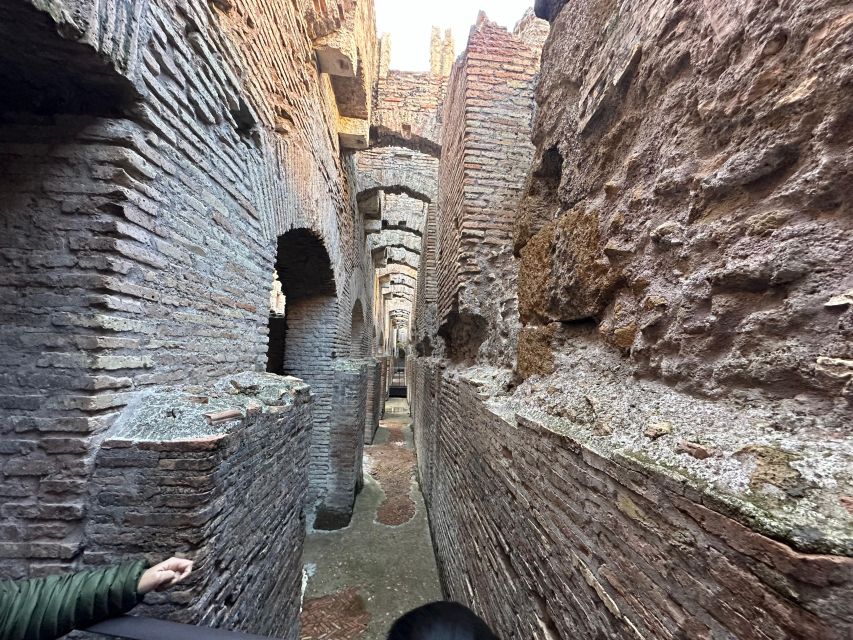
Image Credit: GetYourGuide.com
The Colosseum and Ludus Magnus share a significant connection in ancient Rome’s history. The Ludus Magnus, also known as the Great Gladiator Training School, was located just outside the walls of the Colosseum. It played a crucial role in training and preparing gladiators for the grand spectacles that took place in the Colosseum.
Gladiators were trained in various combat techniques and fighting styles, honing their skills under the watchful eyes of experienced trainers. The Ludus Magnus was a bustling center of activity, with gladiators living and training there.
It served as a vital link between the training of gladiators and their performances in the Colosseum, highlighting the historical significance of Ludus Magnus in the world of gladiatorial combat.
Here's a few more nearby tours and experiences we think you'll like.
- Rome: Colosseum, Palatine & Roman Forum Tour With Fast Entry
- Rome: Vatican Museum, Sistine Chapel&St Peters Guided Tour
- Rome: Borghese Gallery Entry Ticket With Timed Entry
- Rome: 2-Hour Golf Cart Sightseeing Tour at Night
- Rome: Pantheon Skip-the-Line Entry Ticket and Audio Guide
- Rome: Shuttle Bus Transfer to or From Ciampino Airport
Common Questions
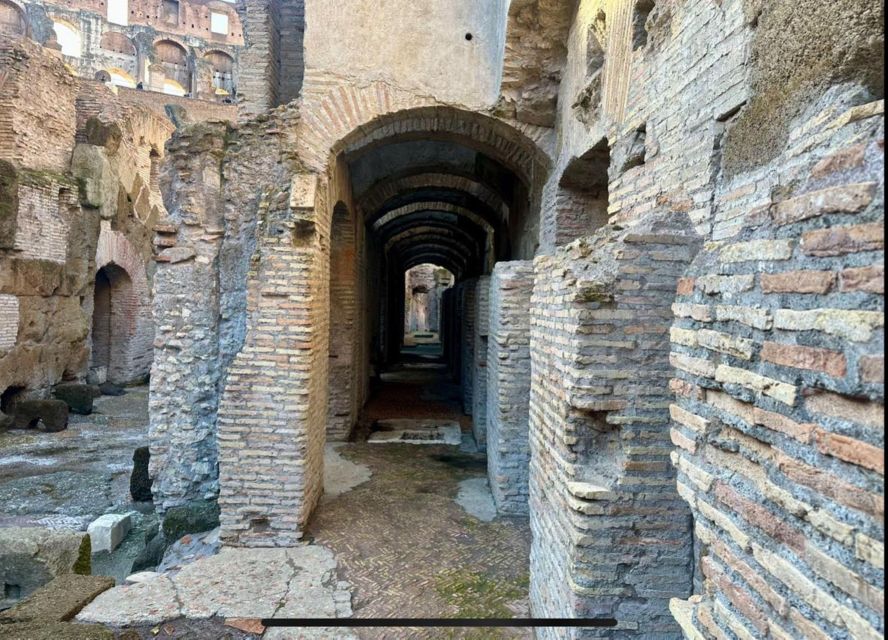
Image Credit: GetYourGuide.com
How Long Does the Colosseum Underground, Arena Floor, and Ancient Rome Tour Typically Last?
The average duration of the tour, which includes the Colosseum Underground, Arena Floor, and Ancient Rome, is typically around 3 hours. Visitors can explore highlights and must-see attractions such as the underground tunnels and the arena floor.
Are There Any Age Restrictions for the Colosseum Underground, Arena Floor, and Ancient Rome Tour?
Yes, there are age restrictions for the tour. Children under the age of 6 are not allowed. Plus, there are photography restrictions in certain areas. Please adhere to these guidelines during the tour.
Can I Take Photos During the Tour?
Yes, visitors are allowed to take photos during the tour. However, there may be some restrictions on photography in certain areas. It is advisable to follow any guidelines provided by the tour guides.
Are There Any Dress Code Requirements for the Tour?
Yes, there are dress code requirements for the tour. Visitors are advised to wear comfortable shoes and clothing suitable for walking. Photography is allowed during the tour, but flash photography and tripods are not permitted.
Is There a Limit to the Number of Participants Allowed on the Tour at Once?
There is a participant capacity for the tour, but the exact number is not mentioned. The tour duration is also not specified. These details would need to be obtained from the tour provider.
Not for you? Here's more of our most recent tour reviews happening neaby
- Global: Esim High-Speed Mobile Data Plan
- Rome: Private Tour of Hadrians Villa With Archaeologist
- From Rome: Private Transfer to Naples or Vice Versa
- Newlywed Couples Blessing During Pope Francis Audience
- From Rome: 2-Day Capri Excursion With Blue Grotto Visit
- Vatican City: Sistine Chapel, Museums, Basilica Private Tour
- 6 Hours Rome Tour With English Speaking Driver
- From Rome: Full-Day Small Group Tour to Venice by Train
- Private Vatican Early Morning
- Paris: Latin Quarter Audio Tour on Your Phone (EN,FR)
- Rome: Private Transfer Between City and Ciampino Airport
- Private Transfer From Naples to Rome or Viceversa
- Rome: Best Squares and Fountains Private Tour
- Italian Food Tasting and Old Rome Private Tour
- Rome: Roman Piazzas With Colosseum and Roman Forum Tour
The Sum Up
To sum it up, a visit to the Colosseum offers a unique and immersive experience into the ancient world of Rome. From the special access to the arena floor and underground tunnels to the exploration of the Roman Forum and Palatine Hill, visitors can truly walk in the footsteps of gladiators and emperors.
By complying with reservation requirements and providing accurate information, one can ensure a seamless and unforgettable journey through the vibrant history of Ancient Rome.
